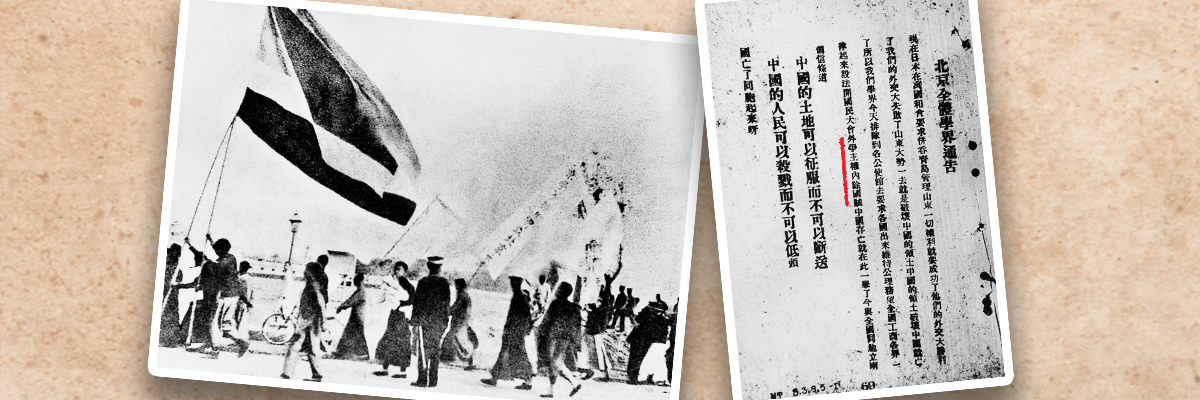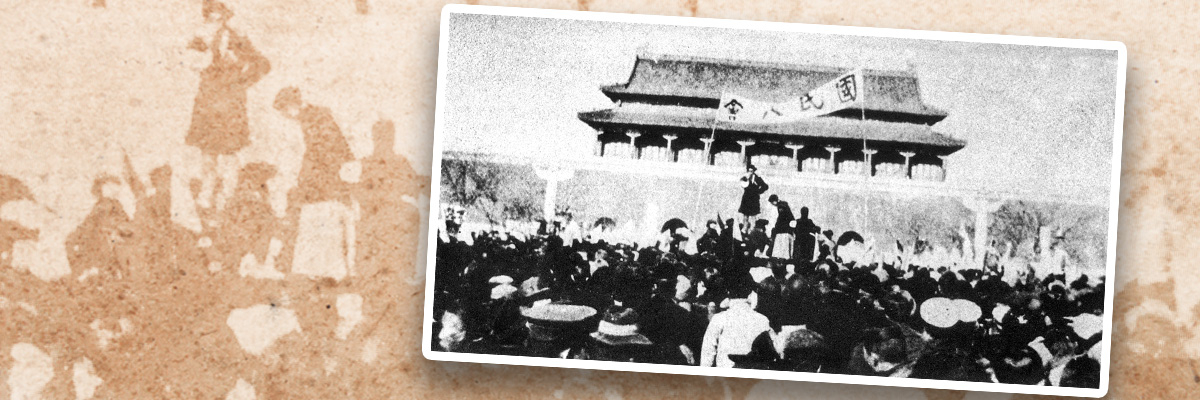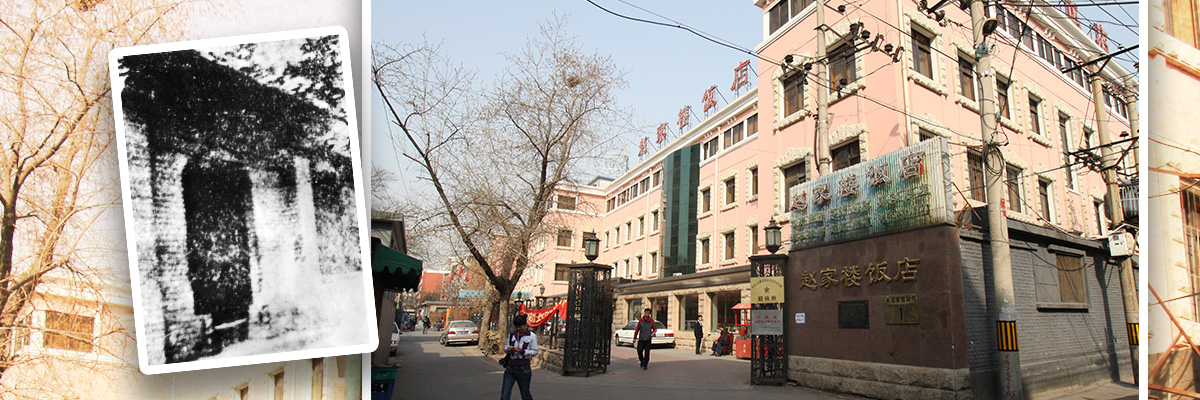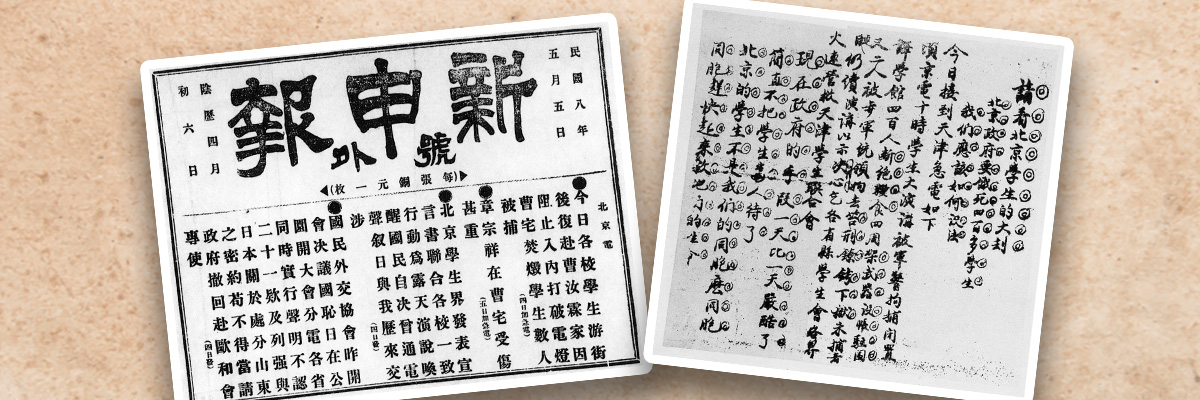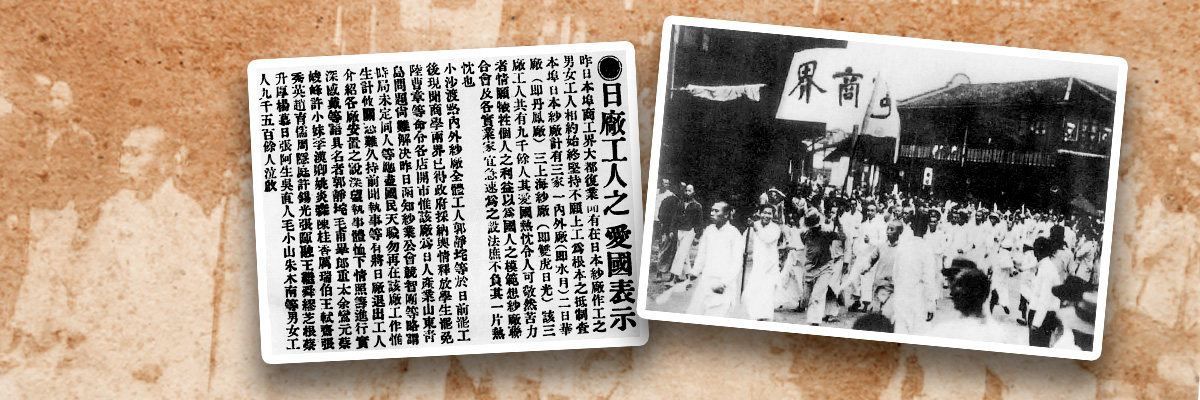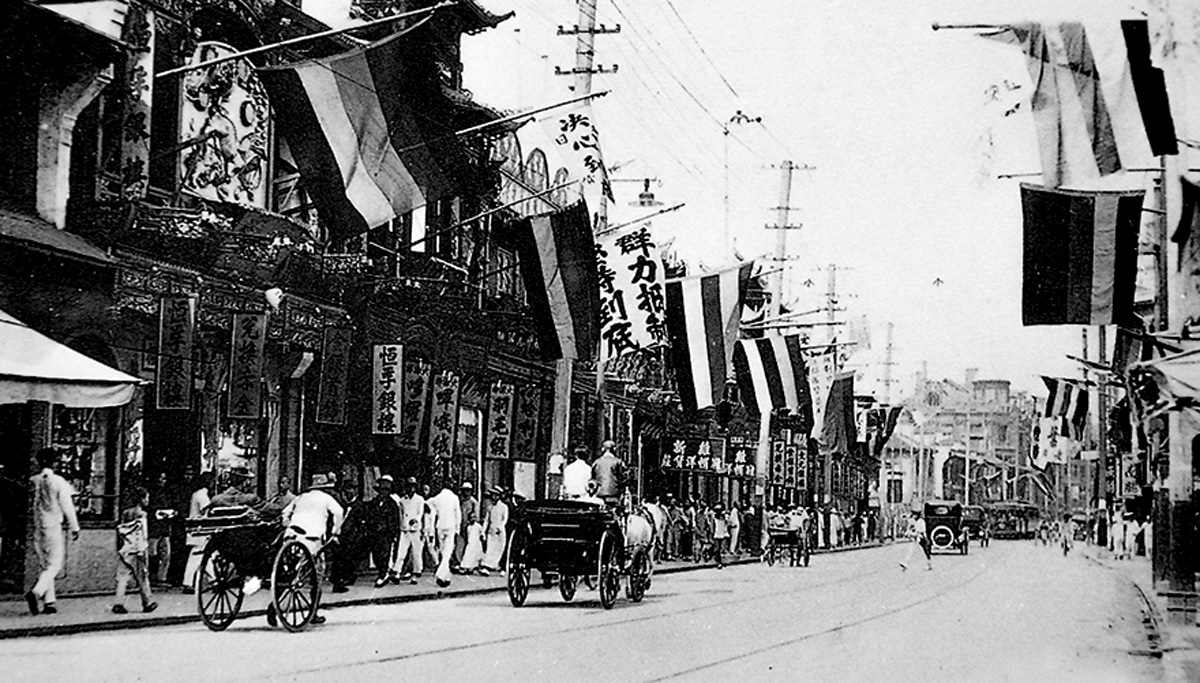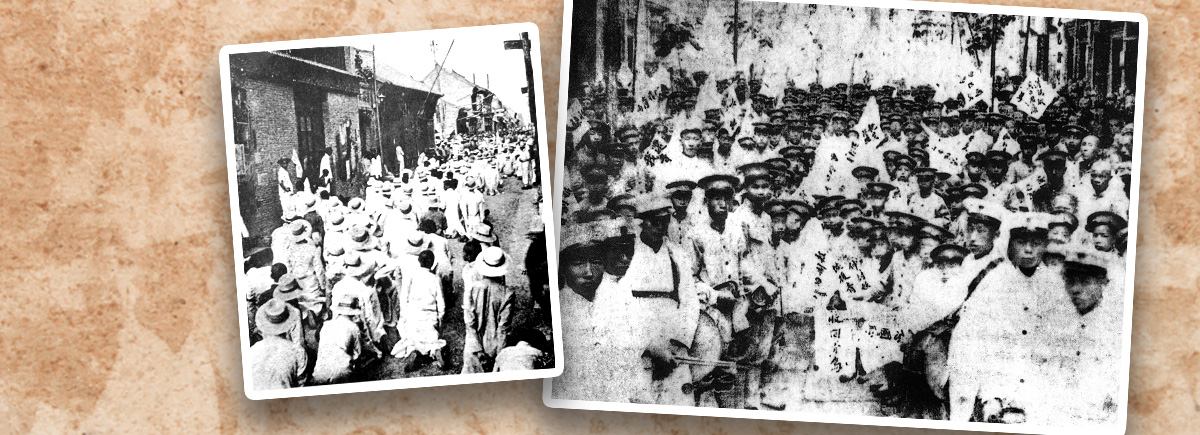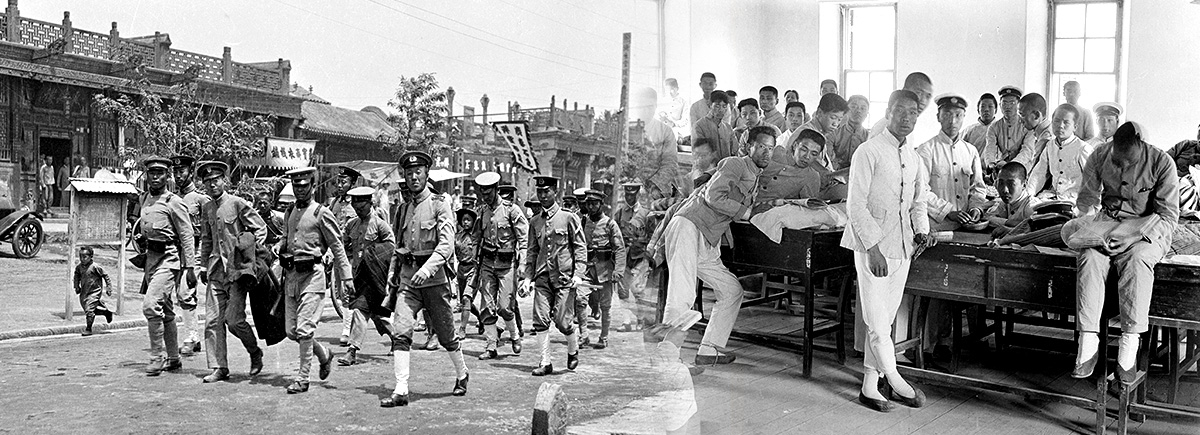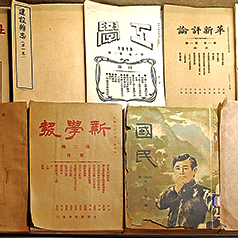Although the May Fourth Movement (五四運動) reflected the long-term influence of the New Culture Movement (新文化運動), it was first a political incident initiated by the student-led patriotic movement that occurred in Beijing on May 4, 1919. The news of China’s diplomatic failure at the Paris Peace Conference sparked national outrage. In the afternoon of May 4, over 3,000 students from 13 educational institutions, with students of Peking University (北京大學) at the fore, gathered at Tiananmen Square (天安門廣場) with a slogan of “struggle for sovereignty externally, get rid of national traitors at home” (外爭主權,內除國賊) and demanded China to defend its national interests in Shandong as well as punish officials responsible for negotiating with the Japanese. These included Cao Rulin (曹汝霖), Minister of Transport; Lu Zongyu (陸宗輿), Director-General of the Chinese Mint; and Zhang Zongxiang (章宗祥), China’s Ambassador to Japan. When the student demonstrators reached Cao Rulin’s residence at Zhaojialou (趙家樓), they beat Zhang Zongxiang and set Zhaojialou ablaze. In response, the Beiyang Government (北洋政府) dispatched military police to arrest numerous students, a move that triggered protests from all classes of society and led to the proliferation of class boycotts, labor strikes and business strikes. Eventually, the government bowed to public wrath and released the detained students. Cao Ruilin, Lu Zongyu, Zhang Zongxiang were also removed from office. At one point, President Xu Shichang (徐世昌) even tendered his resignation. On June 28, China’s representatives refused to sign the Treaty of Versailles. This was hailed as a victory for the May Fourth Movement at that stage.
|
|
The New Culture Movement covered the period from 1915 to 1923. How does the May Fourth Movement fit into the wider movement? |
|
|
See answer below. |
Angered by China’s diplomatic failure at the Paris Peace Conference, throngs of students in Beijing marched to Tiananmen Square on May 4, 1919. A notice by Peking University student Luo Jialun (羅家倫) called Notice to the Entire Academic Community in Beijing (北京全體學界) was disseminated to the demonstrators. It issued a clear call to “struggle for sovereignty externally, get rid of national traitors at home”.
In the afternoon of May 4, 1919, over 3,000 students, with Peking University students at the forefront, gathered in Tiananmen Square with calls to “struggle for sovereignty externally, get rid of national traitors at home”. It was a protest against the Japanese being allowed to assume control of German interests in Shandong, and demanded the punishment of Cao Rulin, Lu Zongyu and Zhang Zongxiang.
A sense of nationalism and patriotism among the Chinese people had steadily risen from the late Qing dynasty to the early years of the Republic. The bullying that China suffered at the hands of foreign powers due to its weakness was particularly resented by young students. When news of the Paris Peace Conference diplomatic failure arrived, it lit the fuse of the powder keg of pent-up frustration.
On May 4, the student demonstrators marched to Cao Rulin’s residence at Zhaojialou and set it ablaze. In response, the Beiyang Government dispatched military police to arrest the demonstrators. The picture on the left shows the burnt ruins of Zhaojialou. The picture on the right shows modern-day Zhaojialou.
Cao Rulin, Minister of Transport, had signed the Twenty-One Demands on behalf of the Yuan Shikai Government while Lu Zongyu, Director-General of the Chinese Mint, had borrowed heavily from the Japanese; Zhang Zongxiang was China’s ambassador to Japan. The trio were blamed for betraying China’s national interests to Japan and branded national traitors by the students. The May Fourth demonstrators went to Cao Rulin’s residence to seize the man himself. Instead of Cao Rulin, they found Zhang Zongxiang there. Mistaking him for Cao Rulin, they beat him up and burned Cao’s residence, an incident later known as the “burning of Zhaojialou” .
The Beiyang Government’s suppression of the demonstration incurred public wrath. On the left, on May 5, 1919, Xinshenbao (新申報), a Shanghai (上海) newspaper, reported on the incident. On the right, an urgent telegram issued by the student unions of Shanghai and Tianjin (天津), rallying the people of China to support the Beijing (北京) students.
A wave of protests quickly spread throughout the country. On the left, on May 7, 1919, over 20,000 people from all walks of society in Shanghai assembled at Nanshi Public Sports Ground (南市公共體育場) in support of the students of Beijing. On the right, on May 9, 1919, students of Tsinghua University (清華大學) burned Japanese products at the sportsground.
United by the same cause, workers and merchants launched labor and business strikes in support of the students. On the left Shibao (時報), a Shanghai newspaper, reported on a labor strike by over 9,000 workers at a Japanese-owned textile factory in China. On the right, merchants took to the streets calling for businesses strikes.
Labor strikes, business strikes and class boycotts proliferated throughout the country during the May Fourth Movement. Among them, the June Third Strike (六三罷工) that occurred in Shanghai on June 3, 1919 drew the most attention. The photo shows closed shops all along Shanghai’s Nanjing Road (南京路); also featured are a banner with the slogan “restrain [the government] together, persevere till the end” and the Republic’s pentacolor national flag.
The May Fourth Movement spread from Beijing to numerous coastal and inland cities, and mobilized a staggering number of people from all sectors in society. Unprecedented in scale, the movement was regarded as the first spontaneous mass movement in near-modern Chinese history. On the left, the people of Jinan (濟南) marching in protest. On the right, a protest gathering held by students in Chongqing (重慶).
The student protesters were undaunted by the threat of government suppression. Both pictures above were taken in June 1919. The picture on the left shows military police patrolling the streets of Beijing, on guard against demonstration activities. The picture on the right shows students incarcerated in a makeshift prison in Beijing.
On June 28, 1919, the Treaty of Versailles was signed at the Paris Peace Conference. In order to calm down public anger, the Beiyang Government finally released the detained students, removed a number of officers including Cao Ruilin, Lu Zongyu and Zhang Zongxiang from office, and refused to sign the Treaty of Versailles. Following these measures, classes, work and businesses resumed, marking the end of the May Fourth Movement. The May Fourth Movement was credited for galvanizing civic spirit and heralding a new era in the development of ideas and culture, social movements and political environment in China .
Although the May Fourth Movement did not result in the immediate return of the German interests in Shandong to China, the movement drew national attention to the issue and China finally achieved a diplomatic breakthrough on this matter. From November 12, 1921 to February 6, 1922, an international conference was held in Washington D.C.. Nine countries were represented comprising the United States, the United Kingdom, Japan, France, Italy, the Netherlands, Belgium, Portugal and China. They met with the aim of limiting the naval arms race and resolving issues in the Pacific and Far East. An imposing Chinese delegation of over 130 people, headed by the plenipotentiaries Shi Zhaoji (施肇基), Gu Weijun (顧維鈞) and Wang Chonghui (王寵惠) was dispatched to participate in the conference. On February 4, China and Japan signed a treaty called For the Settlement of Outstanding Questions Related to Shandong (解決山東問題懸案條約) and its supplementary agreements. It mandated that Japan should return to China the former German Leased Territory and Shandong should be opened to trade. Furthermore, Japan agreed to withdraw its troops from Qingdao (青島) and the Jiaoji (膠濟) Railway Zone and auxiliary rail lines, and return control of the Qingdao Customs, Jiaoji Railway and its auxiliary lines to China. While the supplementary agreement of the treaty did grant various privileges to the Japanese and other foreigners, China nevertheless succeeded in recovering Shandong and its ownership of the Jiaoji Railroad through the treaty and without the threat or use of military force. It answered the May Fourth Movement’s call to “struggle for sovereignty externally” and was regarded as one of China’s major diplomatic victories after the founding of the Republic.
|
|
The New Culture Movement covered the period from 1915 to 1923. How does the May Fourth Movement fit into the wider movement? |
|
|
Though catalyzed by the New Culture Movement, the May Fourth Movement was essentially a national movement best characterized by its slogan “struggle for sovereignty externally, get rid of national traitors at home”. It started with the students’ demonstration in Tiananmen Square on May 4, 1919; by June, it had spread to Shanghai and led to large-scale class boycotts, labor and business strikes in support of the students. As a result, the government was forced to release the detained students and remove Cao Ruilin, Lu Zongyu and Zhang Zongxiang from office. It forced the government to refuse to sign the Treaty of Versailles on June 28. It was considered a victory at that stage, and the movement came to a close soon after. Later on, some of the terms of the Twenty-One Demands were withdrawn when China and Japan signed a treaty called For the Settlement of Outstanding Questions Related to Shandong at the Washington Conference held in 1922. Yet it was not until Japan’s surrender in 1945 that the complete set of demands were abolished. These were some of the aftermaths of the May Fourth Movement. |
Source of most photos used in this feature piece: Fotoe (pictures 1 -7, 9, 10), Visual China Group (pictures 2, 5, 8), misc. photo sources.





